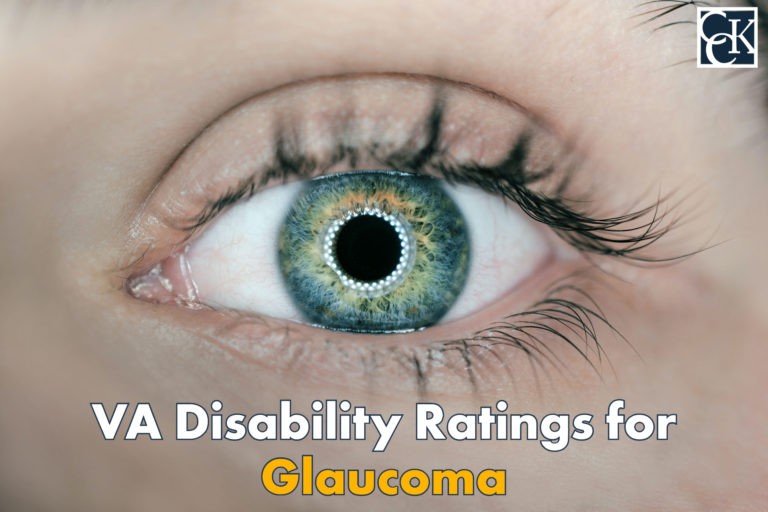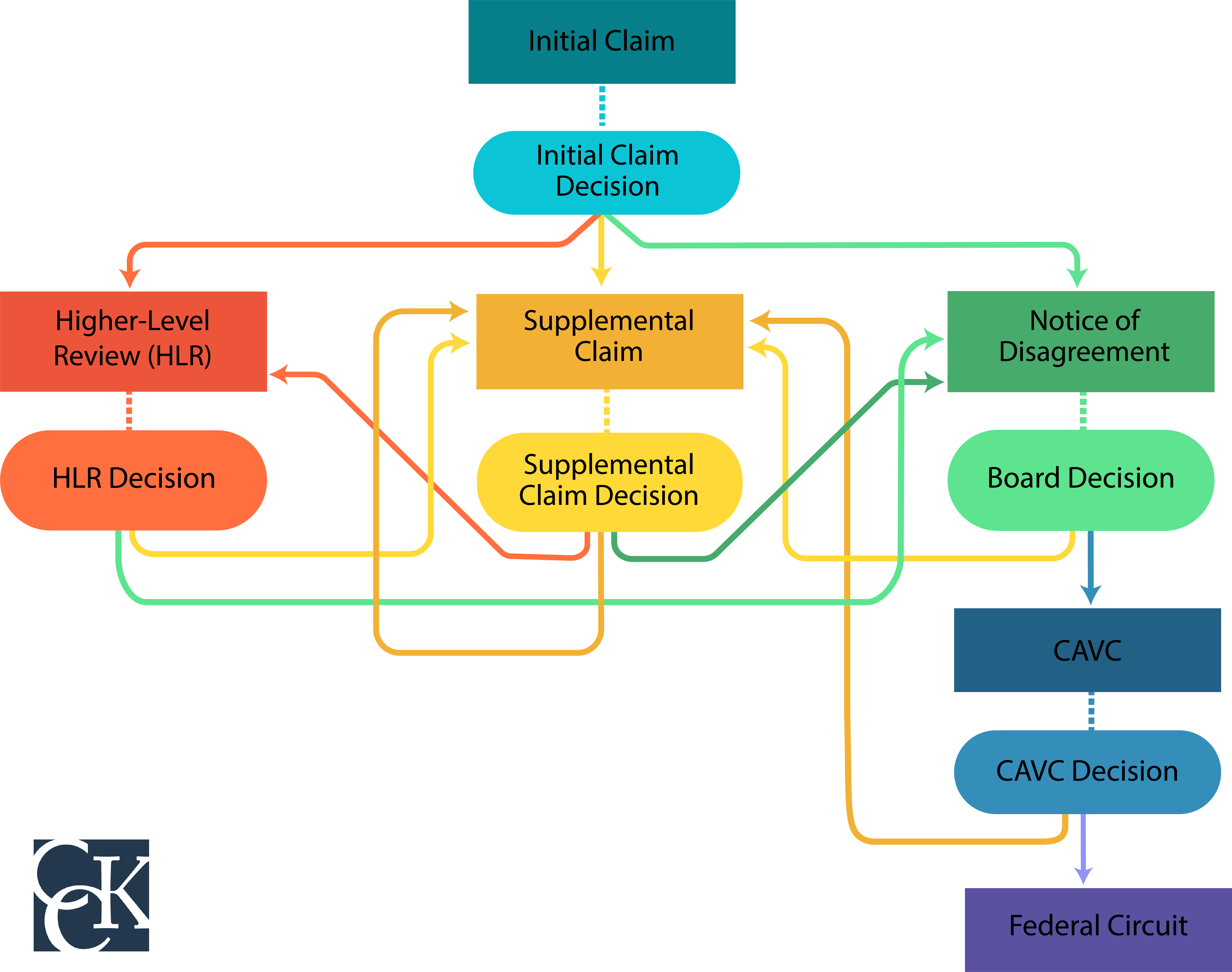Glaucoma VA Disability Ratings and Benefits

CCK Law: Our Vital Role in Veterans Law
Although a common condition, many veterans are unaware that they may be eligible to receive VA disability benefits for their glaucoma. Veterans may file a claim for their glaucoma to become service-connected and receive VA disability benefits.
What is Glaucoma?
Glaucoma is a disease that damages the optic nerves of the eye. It can occur when fluid builds up in the front part of the eye, causing pressure and damage. There are two main forms of glaucoma:
- Primary open-angle glaucoma—This form is the most common. Primary open-angle glaucoma occurs gradually, occurring when the eye does not drain fluid correctly and the pressure begins to build and damages the optic nerve. Usually, this form is painless and causes no vision changes at first, so a person may not even know they have glaucoma.
- Angle-closure glaucoma (Closed-angle glaucoma or narrow-angle glaucoma)—This type of glaucoma occurs when a person’s iris is located close to the drainage angle in the eye. The iris may then prohibit the eye’s proper drainage. When the iris blocks the drainage angle, pressure can build very quickly. This is referred to as an acute attack. A person suffering from an acute attack should see a medical professional as soon as possible, as blindness can occur.
Symptoms of Glaucoma
- Blurry vision
- Severe eye pain
- Headache
- Nausea
- Vomiting
- Vision anomalies, such as halos or rainbow-colored rings
- Eye redness
Diagnosing and Treating Glaucoma
An eye exam will usually be necessary to diagnose glaucoma. This exam can check eye pressure, as well as examine the optic nerve for damage. As many people with glaucoma may not display symptoms, regular screenings are important so as to catch any signs of glaucoma early. Additionally, when a person does display symptoms, they may not be recognized right away as signs of glaucoma. This can often lead glaucoma to be regularly misdiagnosed. Attending regular eye exams with an optometrist is then crucial to ensure that glaucoma is caught early.
There are various methods of treatment which may be used to treat glaucoma. Below are some of the methods which may be used:
- Laser treatment
- Surgery
- Oral Medication
- Eye drops

VA Service Connection for Glaucoma
Generally, approval for VA disability benefits requires three things:
- An in-service event, injury, or illness;
- A current diagnosis by a medical professional; and
- A medical nexus, or link, between your in-service event, injury, or illness and your current diagnosis.
To support the veteran’s claim for service connection, the veteran may submit lay evidence. Lay evidence, or lay statements, can be written by the veteran, their friends, family, coworkers, or anyone who knows the veteran and can speak to their condition. Importantly, lay evidence may also be submitted by fellow service members.
Compensation and Pension (C&P) Exams for Glaucoma
Once a claim for glaucoma has been filed, VA may request a Compensation and Pension exam, or C&P exam. This exam will usually be performed by a VA physician or VA contracted physician. As glaucoma is a condition affecting the eyes, the physician may be an optometrist. They may physically examine the veteran’s eyes or ask questions regarding their military service or symptoms of their glaucoma.
VA will typically call the veteran or send them a letter to schedule their C&P exam. As such, it is crucial to ensure that VA has the veteran’s most up-to-date contact information. If VA does not have current contact information, the veteran might miss a C&P request. Failure to attend an exam, or to reschedule one they have missed, could result in the veteran’s claim being denied.
Prior to the exam, the examiner should review the veteran’s c-file. The c-file will usually contain any documentation that has previously been submitted to VA, as well as the veteran’s medical and military service records.
The veteran may also use a DBQ, or Disability Benefits Questionnaire, to bolster their claim. A Disability Benefits Questionnaire is a form created by VA as a way for veterans to address important aspects of their condition, such as symptoms, severity, possible causes, and relation to other disabilities. The veteran may also have their private doctor fill out a DBQ for them. This can be helpful, as the veteran’s regularly treating optometrist can submit one that speaks to the details of their condition.
How Does VA Rate Glaucoma?
Glaucoma is rated under 38 CFR § 4.79, Schedule of Ratings – Eye. There are generally two diagnostic codes used for glaucoma:
- Diagnostic Code 6012: Angle-Closure Glaucoma
- Diagnostic Code 6013: Open-Angle Glaucoma
If the veteran requires continuous medication for their glaucoma, then VA will assign a minimum rating of 10 percent. Higher ratings may be assigned based on the level of visual impairment or eye disease. Generally, VA will evaluate based on three criteria: central visual acuity, the visual field, and muscle function.
- Central visual acuity— This affects how blurry a person’s vision may be at specified distances.
- Visual Field— This is a measure of the area which the eye is able to see. This includes peripheral vision, upper vision, lower vision, and central vision.
- Muscle Function— Muscle function essentially relates to how well the muscles in the eye can physically move.
In order to qualify for service connection for glaucoma, the veteran will likely need to have significant vision loss or damage to their central or peripheral vision.
Military Burn Pit Exposure and Glaucoma
While many veterans who were exposed to toxins during their service have gone on to develop glaucoma since their military service, VA does not acknowledge presumptive service connection for military burn pit exposure, as it does for other types of exposure.
Military burn pits are large areas of land in which the military and its contractors incinerated all waste generated by military bases, including plastics, medical waste, rubber, human waste, and more.
The U.S. Military used burn pits as part of their waste disposal protocol in places such as Iraq and Afghanistan in the post-9/11 era during Operations Iraqi and Enduring Freedom. While the practice was effective in reducing large quantities of waste, burn pits emitted plumes of toxic smoke. This was especially problematic in places such as the Middle East, as the desert wind carried the smoke for miles.
Many U.S. Military veterans have suffered health consequences from burn pit exposure. Most of the negative effects involve temporary ailments of the respiratory system, though limited evidence suggests a link between burn pit exposure and the long-term deterioration of lung health.
These burn pits were used extensively throughout the Middle East and have affected veterans who served in Operation Iraqi Freedom, Operation Enduring Freedom, and Operation New Dawn.
Research continues to be done to link burn pit exposure to a variety of different conditions, such as cancers and respiratory conditions. While further research will need to be conducted, it has indicated that one of the known chemical compounds which was found in Agent Orange, called TCDD, was also released by burn pits. However, unlike some conditions caused by Agent Orange exposure, VA does not acknowledge presumptive service connection for any condition linked to burn pit exposure.
VA does not have a consistent approach to deciding these claims, so lay evidence from veterans is key to winning burn pit claims. Often, VA does not have a way of proving veterans were near burn pits, so statements from the veteran themselves or buddy statements can help verify exposure.
New Proposed Burn Pit Legislation 2021
As of 2021, there are several major bills currently pending in Congress, that deal with the toxic exposure caused by burn pits. These bills include:
- Conceding Our Veterans’ Exposure Now and Necessitating Training Act (COVENANT)
- Presumptive Benefits for War Fighters Exposed to Burn Pits and Other Toxins Act of 2021
- Veterans Burn Pit Exposure Recognition Act
- Toxic Exposure in the American Military Act (TEAM)
Any of these bills, if passed, would offer needed relief to veterans suffering the toxic effects of burn pit exposure.
Denied VA Disability Benefits for Glaucoma?
VA disability claims for glaucoma can be difficult to win, especially when glaucoma stems from military burn pit exposure. As VA does not recognize presumptive service connection for veterans who were exposed to military burn pits, veterans can often feel hopeless when dealing with their VA disability claim.
However, if you received a denial in your claim for glaucoma, it does not have to be the end of the road. Our experienced VA disability attorneys may be able to help you secure VA disability benefits for your glaucoma. Contact our office today for a free consultation at 800-544-9144.
About the Author
Share this Post



